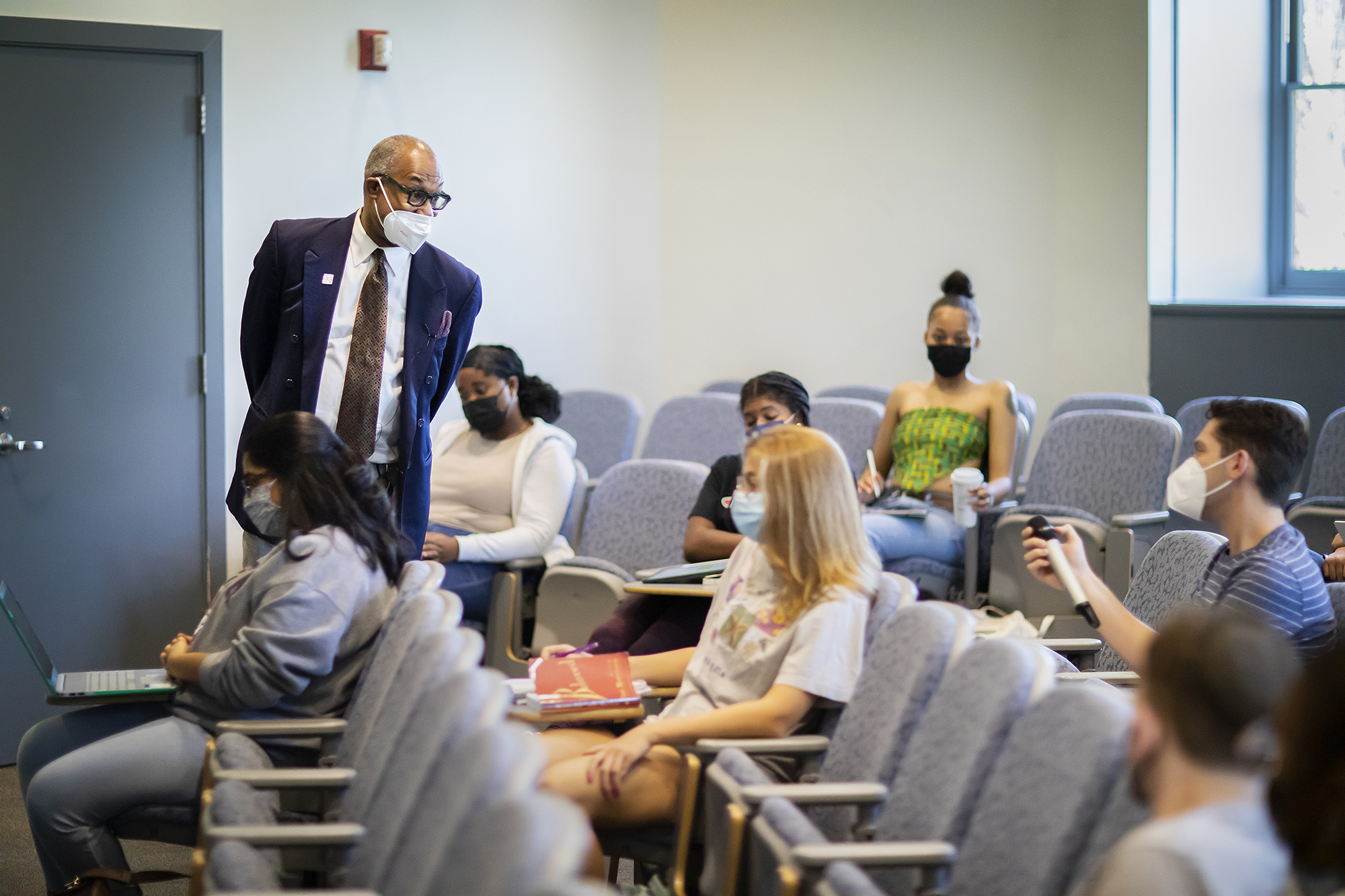
“If you go to 52nd Street on a Saturday morning,” says Herman Beavers, “Black people aren’t thinking about white people, at all. They’re not running through their heads saying, ‘Oh, my God, I can’t buy these jeans because I’m oppressed.’”
Beavers, the Julie Beren Platt and Marc E. Platt President’s Distinguished Professor of English and Africana Studies, is using this vignette to illustrate his point that most Black people, most of the time, are going about the daily business of living their lives. Yet African Americans are often positioned in the news and popular culture as a kind of counterpoint to whiteness, obsessed with their own victimization. What’s missing, he says, are rich depictions of Black interior life.
Enter Toni Morrison. Beavers has been teaching Morrison’s literature for more than 30 years. In his course, Toni Morrison and the Adventure of the 21st Century, students read Morrison’s 11 novels, from “The Bluest Eye” (1970) to “God Help the Child” (2014).
Morrison’s works “consistently engaged the role memory, place, and community play in our lived experience while eschewing the white gaze as a controlling motif,” Beavers says. “In a moment with ever-present discussions about how—and sometimes, if—we value human bodies, reading Morrison’s novels offer an opportunity to think about how we can not only occupy place but also cohabit with our neighbors, whether they look like us, share our point of origin, or reflect our values.”
Beavers draws parallels between Morrison’s books and 21st century events. “When we talk about “Beloved” as a novel about the afterlife of slavery, part of what we’ve got to think about is the fact that the challenge the characters in this novel are facing is how can you turn your gaze forward?” Beavers asks.
Widely considered to be one of Morrison’s masterworks, “Beloved” centers on Sethe, a character who escaped slavery on the plantation Sweet Home only to be haunted by her past.
Addressing the topic in class, Beavers said, Morrison sets Sethe up as the archetype of a strong Black woman and then dismantles it. Then he asked, “Why might the concept of the strong Black woman need to be deconstructed?”
“Black woman should be allowed to not have to be strong,” one student responded. “I have to be constantly put in the face of oppression in order to be valuable, or in order to just be human.”
Sophomore Janay Draughn, an English major concentrating in Africana literature and culture from Greenville, North Carolina, said that the “strong Black woman is dependent on self-sacrifice all the time. And if you’re strong, that means someone else is always able to be weak, or dependent on us.”
Beavers drew the class’s attention to a passage where one of the characters asks Sethe, “How come everybody run off from Sweet Home can’t stop talking about it? Look like if it was so sweet you would have stayed.”
This question is similar to the contemporary query, “Why can’t Black people just get over it?” Beavers said. Part of Denver’s question is asking ‘Why is your gaze and interiority as human beings looking into the past instead of looking forward?’ Beavers said. “For Sethe, the novel tells us ‘The future was a matter of holding the past at bay.’”
People who are opposed to the inclusion of material that discusses slavery as integral to U.S. history suggest that for Black people, “our gazes are just sort of focused on the past,” Beavers said. “But from my standpoint, I’ve been teaching for a long time; we can’t go forward if we don’t figure out a way to own and embrace and embody all of the ways that we all have been dehumanized by the legacy of slavery.”
Racism is akin to looking at a book and thinking you know what’s on the next page without even opening it, Beavers said. If you do that with Morrison, he warned his students, “you’re not going to pass the final. You have to go inside and see what actually happened,” he said. Because of preconceived ideas and opinions, Americans often don’t go deeper; “we regard one another one within the realm of surfaces and melodrama,” Beavers said.
Pulling an example from popular culture, Beavers noted that modern sitcoms often feature “the stereotypical character of the sassy Black woman,” but “we never go to her house; you never find out her back story; she is only visible in the workplace where the sitcom is set,” he said.
These characters are present to add superficial humor or interest but are not fully present as human beings. If the sassy Black woman is “not interesting enough as a character for us to peel back the layers and find out about her in the way that we do about the white characters,” Beavers said, then “popular culture has failed us because it doesn’t give us the vocabulary, or work out the mechanisms by which you can reach the conclusion that Black people have an inner life and therefore are interesting and therefore ought to be regarded as a subject to be explored. Or at least be curious about!”
In addition to lecture and discussion, peer learning is an important part of the course. Beavers structures the class so that it’s centered on the group, with students giving presentations on “deep dive” topics before each session.
“I really appreciated his attention to creating a really thoughtful and inspired learning opportunity,” says Bernadette Butler, currently taking classes in the College of Arts and Sciences. “I felt like every group discussion was a mind map.”
Independent learning encourages students to form their own engagement with the material. In Draughn’s opinion, Toni Morrison “writes for Black people, in the sense that she’s not writing to explain Black people but trying to present or to build up people as humans.
“She created a space for us to have a true, authentic voice,” says Butler. “I would find myself being very emotional in class because she was saying exactly what I wanted to say about some moments of my entire life,” Butler says. “It was just our truth, our plain, unadulterated truth.”
Morrison’s work articulated experiences in a way that allowed Butler to process her own life experience, she says. “I felt like I was having an out of body experience. Like I was standing over myself watching what was happening to me and having someone else narrate it or speak for me because my voice had been stolen because I didn't want to acknowledge what was happening.”
Butler, from West Philadelphia, is currently taking classes to complete her undergraduate degree while working full time as an undergraduate administrative coordinator at the Wharton School. “As I get older, I’m trying to go to a deeper level rather than just be entertained,” she says. “I think Toni Morrison presents you with the opportunity. If you take the challenge to go deeper, she definitely presents the platform.”








